
August 2013
No to the Trap of “Dialogue” with the Strikebreaking Government!
Mexican Powder Keg
Turn the
Teachers’ Walkout Into a
National Strike Against the Reforms
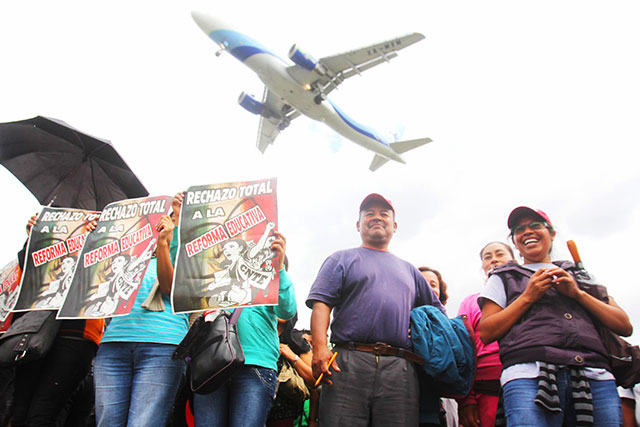
The CNTE has carried out unprecedented actions. Here teachers blockade the Mexico City International Airport on August 23. (Photo: El Internacionalista )
Answer Repression with
Hard-Hitting Workers Action Everywhere
The CNTE Should Finally Bury the Corporatist SNTE!
AUGUST 29 – For two weeks, the battle-hardened teachers of the National Coordinating Committee of Education Workers (CNTE) have thrown Mexico City into turmoil with huge, combative, roiling protests unlike anything seen in the Mexican capital before. Tens of thousands of furious teachers shouting “betrayal” have launched a multi-state walkout of the public schools against the privatizing educational “reform” by the federal government. This anti-reform was engineered by the “Pact for Mexico” of the three main capitalist parties – the PRI, PAN and PRD – who together hold the vast majority of seats in Congress, following orders from the imperialist financial organs. With its action, the CNTE has rolled right over the obstacle posed by the corporatist National “Union” of Education Workers (SNTE), which acts as labor cops of capital.
This teacher rebellion has nothing to do with the obligatory labor parades of the corporatist federations, nor the endless marches which lead worker protests to the dead-end of the “popular front” of the bourgeois nationalist opposition. In a succession of unprecedented actions, the CNTE set up an enormous tent city of some 40,000 teachers covering the Zócalo (Mexico City’s vast main square, in front of the National Palace) and extended several blocks in every direction into the Historical Center of the city; the teachers drove the two houses of the National Congress out of their respective chambers, as well as surrounding the Federal Palace of Justice and the Federal District Public Security Department; and then they shut down access to the international airport for nine hours.
The action of the combative teachers sent the Mexican ruling class into a fit, particularly its most right-wing political representatives. The bourgeois media have created a lynch-mob frenzy, whipping up popular hysteria against the strike. But faced with the strikers’ steadfast will to struggle, the government of Enrique Peña Nieto, of the Institutional Revolutionary Party (PRI)1, finally made a few formal concessions: it agreed to postpone discussion and approval of the Professional Teaching Service law, and in order to lift the blockade of the airport it agreed to a “round-table dialogue” in which the CNTE could present its positions.
The “moderate” CNTE leaders have presented these two steps as an important achievement. However, this “dialogue” is a fraud, and more than that, a trap. As Peña Nieto, his education secretary Chuayfett and his interior secretary Osorio Chong all say in unison: they aren’t going to negotiate anything. Moreover, by only taking up the teaching service law, they portray the teachers as only interested in their own jobs, and not in the students. On the other hand, if the CNTE agrees to anything, it will become an accomplice to the attack on the teachers’ rights. And meanwhile, the ground is being prepared for repression. As Julio Hernández wrote in his newspaper column, “the ‘reforming’ powers … are readying the iron fist inside the silken glove of ‘dialogue’” (La Jornada, 26 August).
Without a doubt, the government misjudged the tenacity and the capacity of resistance of the teachers. Otherwise it would not have presented its educational “reform” only a few days ahead of opening discussion on the energy (oil and electricity) reform. It figured it could submit the secondary laws implementing the educational counter-reform for a vote without any blowback. The fact that the president had to twice change the place and now the date of his first annual Report (equivalent to the State of the Union address in the U.S.) – from the Chamber of Deputies in San Lázaro Palace to the Military Field of Mars (with its indelible martial image) and finally holed up in the presidential residence of Los Pinos – demonstrates the impact of the teacher protests. But Congress has already been surrounded by the wall of steel that was set up for the Peña Nieto’s inauguration last December 1, police reinforcements have been called into the Federal District from Mexico state, and the ombudsman of the capital has given his blessing in advance to the repression.2
All signs indicate that, “dialogue” or not, they are preparing to push through approval of the last of the secondary (implementation) laws with lightning speed. The vote will take place “sooner than people think,” said the PRI chairman of the Permanent Commission of Congress. The opening of the regular session of Congress has been called for September 1. Voting and presidential signing of the law will take place forthwith. Teachers will then be faced with an accomplished fact. But that won’t stop the advocates of impotent pressure politics: they will follow up with calls for injunctions and petitions to the Supreme Court, all doomed to fail, because the capitalist state is not neutral but instead, as Karl Marx, Friedrich Engels and all the great Marxists emphasized, it is a machine for subjugating working people in the interests of capital.
Neither Corporatism Nor Popular-Frontism!
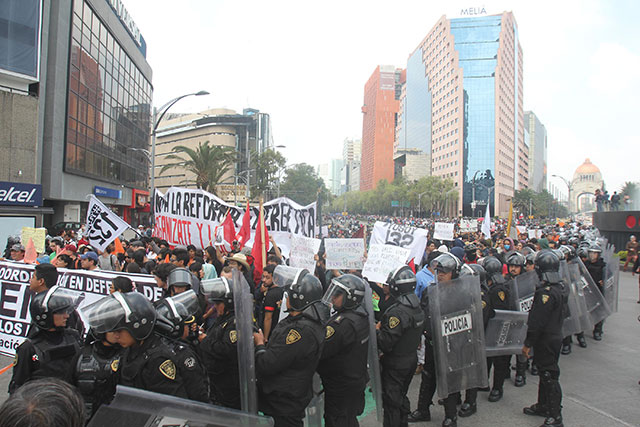
The government readied “the iron fist inside the silken glove of ‘dialogue’.” Repession against demonstrators on the day of Peña Nieto’ first annual Report, September 1. (Photos: El Internacionalista)
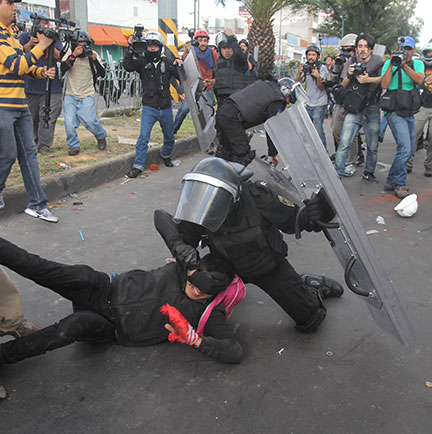 A serious strategic
discussion is urgently needed about the prospects of this
vital struggle. The future of the teachers and universal,
free, public, secular education in Mexico are at risk. If
implemented, this union-busting “reform” instigated by
international finance capital could lead to tens, and perhaps
hundreds of thousands of firings – as well as to a brutal
privatization of the school system, with the concomitant
exclusion of the neediest students by means of introducing
school fees. In Mexico, it must be emphasized that Peña
Nieto’s reform has the approval of all the bourgeois
parties. How, then, can the combative teachers win against
this concerted attack by the whole of the capitalist class?
A serious strategic
discussion is urgently needed about the prospects of this
vital struggle. The future of the teachers and universal,
free, public, secular education in Mexico are at risk. If
implemented, this union-busting “reform” instigated by
international finance capital could lead to tens, and perhaps
hundreds of thousands of firings – as well as to a brutal
privatization of the school system, with the concomitant
exclusion of the neediest students by means of introducing
school fees. In Mexico, it must be emphasized that Peña
Nieto’s reform has the approval of all the bourgeois
parties. How, then, can the combative teachers win against
this concerted attack by the whole of the capitalist class?
The starting point is that the fight must be waged on the basis of revolutionary class independence of the workers movement with regard to the capitalist state and all the parties, politicians, coalitions and political currents of the bourgeoisie. The policies of the CNTE leadership are quite different. Although it has distanced itself more than in the past from the charro (cowboy) leaders of the corporatist SNTE, criticizing their submission to the PRI government, its orientation consists of pressuring the bourgeois state. The CNTE tops even hailed the arrest of the SNTE president-for-life Elba Esther Gordillo, although this was a blow basically aimed, not at the SNTE, which has always dutifully served its official masters, but against the combative teachers who have resisted the privatizers’ plans.
The National Coordinating Committee of Education Workers, like the Mexican Union of Electrical Workers (SME) and a host of “independent” unions and union tendencies (as well as quite a few groups which misleadingly call themselves socialist) over the last quarter century have followed the path of the popular front around the figure of Cuauhtémoc Cárdenas and the Party of the Democratic Revolution (PRD) and more recently around Andrés Manuel López Obrador (AMLO), who now heads the National Regeneration Movement (Morena). This class-collaborationist coalition serves to subordinate the workers movement, peasants, students, indigenous peoples and other oppressed sectors to the nationalist and populist wing of the bourgeoisie.
While Morena has been practically invisible in this struggle – as was AMLO in Oaxaca during his 2006 presidential election campaign, when he didn’t set foot in the state and was quite tight-lipped about the teachers’ selfless struggle – the popular-front orientation of the CNTE leadership was set out clearly in its adherence to the “Proclamation for the Nation” calling the Saturday, August 31 march against the energy reform (see box). That proclamation is based on defense of “national sovereignty.” But this sovereignty – i.e., exercising supreme authority within the national territory – is precisely what Peña Nieto is going to use against the teacher rebels and the opponents of his plans to privatize Mexico’s energy resources.
The Grupo Internacionalista, based on the Bolshevik policies of Lenin and Trotsky, defends the independence of semi-colonial nations oppressed by imperialism as part of the struggle for workers revolution. In defending the nationalization of oil and electrical energy, we fight for the expropriation of all the capitalist parasites which feed off Petróleos Mexicanos (Pemex) and the Federal Electricity Commission (CFE) – including the Mexican capitalists – and for workers control by the workers occupying the plants and installations, both against the Mexican state and the corporatist pseudo-union, the STPRM, which is getting ready to join in the capitalist banquet to carve up the juiciest parts of the state company.
In politically combating popular-frontism, the GI insists that you can’t defeat the impending repression and repeal the secondary laws along with the amendments to Articles 3 and 73 of the Mexican Constitution by pressuring the bourgeois parties and politicians. The spokesmen for capital will not be convinced by arguments about the best way to improve education, which in any case is not what they are after. They only understand power. The strength of the working people is based on their role in producing value. It is therefore necessary to turn the teachers walkout into a national strike against all the anti-working-class reforms: educational, energy and labor. Repression must be answered with hard-hitting workers action throughout the country.
It’s necessary to mobilize all sectors of education (community colleges, National University [UNAM], Polytechnical Institute [IPN], Metropolitan University [UAM], Mexico City University [UACM] and the other universities), along with health workers, social security (IMSS) workers and telephone workers, Mexico City metro (subway) workers, Nissan auto workers from Cuernavaca, workers from the steel plants in Lázaro Cárdenas and in general the “heavy battalions” of the proletariat which have the power to shut down the capitalist production machine. One can occupy the Zócalo for quite a while, and even block Mexico City’s Reforma Avenue for two and a half months, as López Obrador did in 2006, without having an effect. But teachers blocking some Pemex refineries in cooperation with the oil workers for a week would be quite a different story.
The Internationalist Group also underlines that this battle against the capitalist anti-educational “reform” is a key moment in the struggle against corporatism, which has been the main obstacle to workers’ struggles in Mexico since the 1930s. The arrest of La Maestra Gordillo and her replacement by her lieutenant Juan Díaz de la Torre didn’t change one bit the nature of the SNTE as an instrument of government control of labor. An August 20 statement by the Coordinadora says, “Today, with its Indefinite National Work Stoppage, the CNTE has confirmed that in actual deeds it is the genuine union, dealing a stunning defeat to the charro unionism of the SNTE.”3 Correct, and now that the outfit headed by Gordillo and Díaz is supporting the anti-teacher laws to the hilt, it’s time to bury this rotting corpse.
Above all, the struggle over the educational counter-reform is political, and must be fought politically, seeking to form the nucleus of a revolutionary workers party fighting for a workers and peasants government to undertake socialist revolution and extend it internationally. As a North American comrade, who is a union delegate in the United Federation of Teachers in New York and an activist of Class Struggle Education Workers, emphasized in speaking with teachers from Oaxaca in the tent city and blockades, the offensive against teachers is international in scope, affecting the U.S. as well as Mexico, and it isn’t just a policy (“neo-liberalism”) but the product of capitalism.
Chronology of the Teacher Rebellion
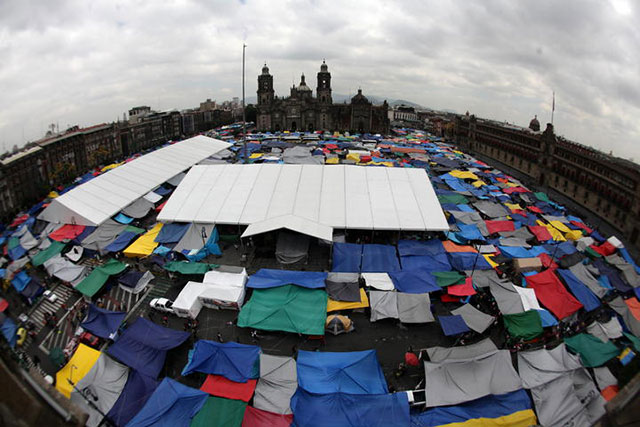
The Zócalo, Mexico City's vast main square, bordering the Cathedral (center) and the National Palace (right), was entirely filled by the CNTE tent city. Up to 40,000 teachers camped out there for weeks, braving cold and heavy rain. (Photo: Sección 9, CNTE)
Ever since it was agreed upon by the Pact for Mexico on 2 December 2012, the day after he took office, PRI president Peña Nieto has sought to have his educational “reform” pushed through on the fast track. The proposed constitutional reform was sent to Congress barely a week later. Presented on December 10, it was approved with few changes by the Chamber of Deputies on the 19th, and by the Senate two days later. Then the changes to Articles 3 and 73 of the Mexican Constitution were ratified by the majority of states in record time, with the amendments validated on February 6 and promulgated by Congress on the 25th.
One day later, Gordillo was arrested, charged with misappropriation of funds, as if her shopping trips to the luxury Neiman Marcus department store in Dallas were the worst of her crimes. The Grupo Internacionalista warned that the blow by the government was not directed against the SNTE, which under leaders handpicked by the Mexican president, from Carlos Jonguitud (who ran it from 1974 to 1989) to Díaz de la Torre, has invariably and dutifully served the employer state, but against the CNTE. We demanded, “Let the Government Agent Gordillo Go, So Teachers Can Try Her for Murder!” (The Internationalist No. 34, March-April 2013).
Shortly afterwards, the combative teachers strike led by the Guerrero State Coordinating Committee of Education Workers (CETEG) broke out. The Guerrero teachers went after the PRD governor Ángel Aguirre and the parties that voted for the state “reform” law (PRD, PRI, PAN and Citizens Movement), breaking windows and setting fire to party offices. They also stoned the offices of two corporatist agencies, the CTM and the hated SNTE (see “Mexico: For a National Education Strike!” and “Defend the Independent Teachers of Oaxaca,” The Internationalist No. 35, Summer 2013). Unfortunately the CNTE did not call strikes in other states and the Guerrero teachers remained isolated.
In the face of the boiling anger of the teachers, the federal government agreed to hold regional forums on the educational reform and to submit the results to the legislative bodies. The CNTE organized the forums in ten states, with more than 10,000 participants. The proposals were collected and given to the government, which passed them on to the members of the Pact for Mexico, which in turn ... did nothing. The legislators who debated and approved the secondary laws never saw the proposals. It’s not surprising, therefore, that the teachers cry “fraud.” But in reality, the PRI and its satellite parties never intended to take them into account. They only sought to “manage” the protests and run them into the ground (see “Traición y venganza” [Betrayal and Revenge], Proceso, 25 August).
On August 14, Peña Nieto sent the three implementation laws to Congress. Seeing that they had once again been swindled by the federal government, the teachers responded with hard-hitting action. In its August 17 state assembly, [CNTE-led] Section 22 (Oaxaca) voted unanimously and with massive support from the ranks to undertake a campaign of struggle by calling an indefinite work stoppage. They decided to send their 74,000 members to Mexico City to set up a tent city in the Zócalo of the capital. The bourgeois press [of Oaxaca], from the conservative El Imparcial to the liberal Noticias, reacted with fury, baying for teachers’ blood, while many teachers set out for Mexico City vowing that they would bypass the timid CNTE leadership.
That same weekend, Section 18 (Michoacán) also decided to walk out. Teachers in Tabasco did the same, but over their own local demands. On Wednesday August 21, teachers of Section 9 in the Federal District began a 48-hour strike. Later Section 7 in Chiapas began an indefinite walkout starting on August 28. Meanwhile contingents of teachers began to arrive from 20 different states to strengthen the camp in the capital, turning it into the largest in Mexico’s recent history. The Federal District government, led by Miguel Ángel Mancera and the bourgeois PRD, called on the teachers not to use Mexico City as a “battleground.”
On Monday, August 19, amid fears of a legislative albazo (pre-dawn attack) in which the laws implementing the educational reform would be pushed through without discussion, teachers from Section 22 marched on the Chamber of Deputies. At San Lázaro Palace (site of the Chamber), legislators high-handedly refused to receive a commission, which led to a confrontation in which teachers defended themselves with whatever they could lay their hands on against the police. Nevertheless, the Chamber’s education commission approved the three laws. In response, on Tuesday, August 20, the CNTE blocked Paseo de la Reforma, and in an “operación hormiga” (operation ant swarm) starting at 3:30 a.m. on Wednesday, August 21, they “took” the Chamber of Deputies, surrounding the building with thousands of teachers.
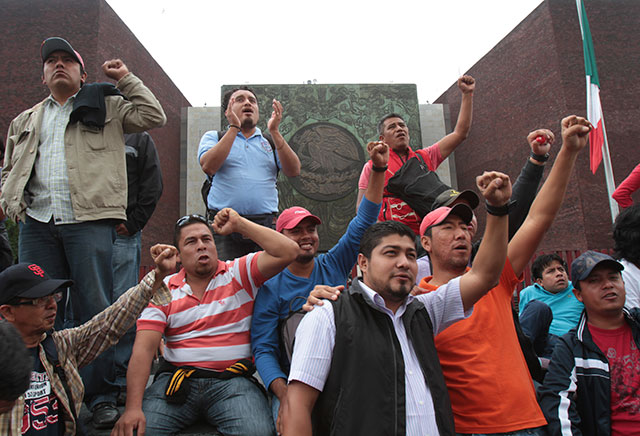
Teachers ran the Congress out of the capital: the Chamber of Deputies at San Lázaro was surrounded by thousands of teachers (above) to avoid a legislative “albazo” (pre-dawn attack). Nevertheless, the deputies headed for the Senate, which in turn was also blckaded. Finally the Congress took refuge in the Convention Center of Banamex (a subsidiary of Citibank) on the city limit with Naucalpán in the state of Mexico, located next to Campo Militar No. 1. (Photos: above, Cuartoscuro; below Notimex and Iván Stephens/Cuartoscuro)
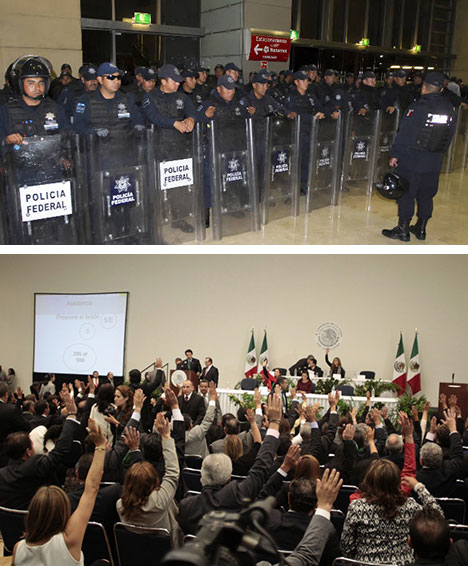 When during the day the
deputies tried to move their session to the Senate, a blockade
by hundreds of teachers was set up there as well. Finally,
both chambers of Congress fled to the outskirts of the city,
18 kilometers from their respective palaces, to set up shop in
the convention center of Banamex (a subsidiary of Citibank)
located next to Military Camp No. 14 on the boundary
between the Federal District and the surrounding state of
Mexico. In that venue, that symbolized the role of parliament
as the servant of big capital protected by its armed fist, the
police and military officer corps, in the early morning hours
of August 22 the deputies approved, in a mere seven minutes,
the establishment of a National Institute of Educational
Evaluation as well as the General Education Law, leaving on
the table the Professional Teacher Service Law.
When during the day the
deputies tried to move their session to the Senate, a blockade
by hundreds of teachers was set up there as well. Finally,
both chambers of Congress fled to the outskirts of the city,
18 kilometers from their respective palaces, to set up shop in
the convention center of Banamex (a subsidiary of Citibank)
located next to Military Camp No. 14 on the boundary
between the Federal District and the surrounding state of
Mexico. In that venue, that symbolized the role of parliament
as the servant of big capital protected by its armed fist, the
police and military officer corps, in the early morning hours
of August 22 the deputies approved, in a mere seven minutes,
the establishment of a National Institute of Educational
Evaluation as well as the General Education Law, leaving on
the table the Professional Teacher Service Law.
Hours later, the Senate followed suit. On Friday, August 23, given the “hear nothing, see nothing” policy of the legislators, the teachers carried out an exemplary action: they laid siege to the Mexico City International Airport, occupying the approaches on the Interior Circuit highway for more than nine hours. Reeling, the federal government agreed to round-table negotiations in order to get the teachers to retreat. But the moment the last teacher left, government secretary Miguel Ángel Osorio Chong announced that nobody would hold back the educational reform, nor would he give in to “those who want to drag our country into confrontation, into violence,” and that if dialogue would not work, he would impose “the dominion of law.”
At present we are witnessing the theater of “dialogue,” in which the legislators “listen with deaf ears,” as one CNTE leader put it, while on the streets the police and military forces prepare their attack. Government spokesman have made it clear that, once the president’s Report has been delivered, the last of the “reform” laws will be passed on September 2. Teacher union leaders declare that they will hold the government responsible “for the foul-ups that will then be visited on the entire country,” and that “the CNTE will leave Mexico City in the following days to undertake ‘a strategy of prolonged struggle in various regions’.” But their only strategy is to wear down the movement with endless popular-front mobilizations.
A Capitalist Assault on Public Education
During the 12 years of PAN (National Action Party) governments of Vicente Fox and Felipe Calderón, the federal government signed agreements with the corporatist SNTE under the so-called Alliance for Educational Quality (ACE), including the Universal Evaluation of teachers, the Enlace student exams, and competitive job placement. In order to carry out these measures, the SNTE not only received millions in subsidies from the federal budget, it also filled key positions in the federal Public Education Department and its state-level equivalents. These “reforms” were resisted with particular determination in the states of Oaxaca, Michoacán and Guerrero, strongholds of the CNTE, where year after year teachers have burned the tests and blocked the “productivity” methodology of the so-called professional teaching career.
This whole plan was spawned by the international financial organs of the IMF (International Monetary Fund), the World Bank and the OECD (Organization for Economic Co-operation and Development). These agencies also demanded that Mexico introduce tuition in public universities, setting off the ten-month 1999-2000 UNAM strike which ultimately preserved free higher education in the National University. Now with Peña Nieto as president, together with his team of neo-“scientific” PRI technocrats,5 the whole of the Mexican bourgeoisie is trying to raise the imperialist privatization dogmas to the level of constitutional precepts, with a particular effort to destroy the “hindrance” represented by the CNTE and teacher resistance.
In its coverage of the teacher insurgency, Proceso (August 25) included an article titled, “The Guillotine Is Hidden in the Implementation Laws.” Let’s take a look at what they include, not only as concerns teachers but also parents. For example, the fifth transitory (interim) clause of Article 3 of the Constitution indicates that the government should “strengthen the autonomy of school management with the aim of improving its infrastructure, purchasing educational materials, resolving basic operational problems and promoting conditions for the participation of students, teachers and parents, under the leadership of the school principal, in the course of resolving the challenges that each school faces.”
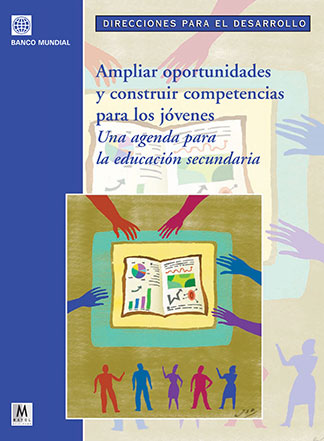 Capitalist assault on
working people and public education. The diktat of the World
Bank expands opportunities for capital to profit from
education, and for working-class parents to “contribute” money
they don't have.
Capitalist assault on
working people and public education. The diktat of the World
Bank expands opportunities for capital to profit from
education, and for working-class parents to “contribute” money
they don't have.The sugary words of “autonomy,” “purchasing educational materials” and “participation” by parents may sound nice, but in reality they are a smokescreen for a plan to gradually reduce the federal government’s financial commitment to education and replace it with “contributions” from families. This is how they seek to implement a dictate of the World Bank, which stipulated:
“Taking into consideration the heterogeneity of the clientele of secondary education, and the fact that this educational level has a smaller likelihood of a community base and of being able to finance itself based on local taxes or contributions in kind, families may be required to make private contributions.” [our emphasis]
–World Bank, Ampliar oportunidades y construir competencias para los jóvenes: Una agenda para la educación secundaria (Expanding Opportunities and Building Competencies: A New Agenda for Secondary Education) [2005]
This demand of the World Bank reflects the interest of the big capitalists in reducing their tax “contribution.” Thus we can see how in the name of school autonomy,” the principle of universal free, public, secular education is being undercut, to the detriment of the most needy, whose families do not have the resources to make “private contributions” – nor should they have to.
As for the labor rights of teachers, the educational “reform” not only follows the dictates of the IMF, the World Bank and the OECD, it is also inspired by the virulent anti-union propaganda of “non-governmental” organizations (ONGs) like Mexicanos Primero (Mexicans First) of Claudio X. González, sponsor of the film ¡De panzazo! (Barely Passing), financed with millions coming from private enterprise. According to these enemies of public education, if telesecundaria schools6 have no televisions, if the children suffer from undernourishment, if classrooms don’t have benches or blackboards, if on standardized tests Mexican children can’t compete with children from Finland, it’s the fault of “bad teachers.” The solution: fire them.
Thus Article 53 of the bill for the Professional Teacher
Service Law decrees that “in the case of someone who does not
join the programs for regularization or doesn’t achieve a
passing score in the required third exam, the effects of their
appointment will be rendered null and void , with no
responsibility incurred by the educational authority.” What
this means is that any educators who refuse to participate in
the “voluntary” evaluation, or whose answers are not to the
liking of the “experts” of the National Institute of
Educational Evaluation, whose monopoly in this respect is now
enshrined in the Constitution, will be fired, with no right to
appeal to the labor courts.
And in order to stop teachers from carrying out more marches and work stoppages in defense of their rights, Article 76 of the same law dictates that “teaching personnel and managerial and supervisory personnel … who do not carry out their tasks for three consecutive days, or non-consecutive days in 30 calendar days, without just cause, will be separated from public service, with no responsibility incurred by the educational authority.” With this they are threatening to fire the entire teaching workforce for any strike.
As telesecundaria teacher Pedro Ramírez Vázquez wrote in an article recently published in La Jornada (24 August):
“Let no one be fooled, the federal government, the members of the Pact for Mexico, the chambers of deputies and senators, are not interested in the education of the children and youth of our country, much less improving educational services. Ever since December 2012, with the approval of the so-called educational reform, they have hoodwinked, distorted and lied – and they continue to do so – to public opinion and parents. The deterioration of education will not be resolved by placing education workers in the pillory.”
The government acts as if the cause of Mexico’s low educational level is rooted in the lack of evaluation of teachers. This is not simply a question of blindness regarding the social reality of the country on the part of the government or the Pact for Mexico. The bourgeoisie is consciously trying to get rid of free public education reaching into every corner of the country. The standardized exams of students will indicate the “yield” of each school and every teacher. This policy of treating education as a commodity is aimed at shutting down schools which don’t measure up to efficiency standards and getting rid of rebellious teachers.
In a country where there is an abyss separating the city and the countryside, where official statistics show 7.5 million people suffering from famine, where thousands of rural communities lack basic services such as running water, electricity and drainage, how can students in these areas achieve an “efficient” score in an Enlace exam? How can a female pupil whose native language is Zapotec, or Mixtec, Mixe, Náhuatl or one of the various Mayan languages, achieve a score on a Spanish-language exam comparable to students living in middle-class areas of the major cities?
Marching on the presidential residence of Los Pinos on August 28, the teachers chanted, “If there is no repeal [of the education “reform” Constitutional amendments] there will be a revolution!” In fact, in order to improve education in Mexico it will take nothing less than a socialist revolution that sweeps away this system of exploitation which constantly reproduces massive poverty and social discrimination while depriving public schools of the most basic necessities. Instead of demanding “private contributions” from impoverished families, as the OECD “experts” and the “scientific” technocrats of the PRI regime do, a genuine educational reform would begin by providing free breakfasts and lunches to all students. You can’t learn on an empty stomach.
The Struggle for Socialist Revolution
We Trotskyists of the Grupo Internacionalista have intervened in the current battle to defend public education and teachers against the assault by capital. We have sold hundreds of copies of our newspaper, Revolución Permanente, with articles on the fight against the anti-education “reform.” We have intervened in assemblies of Section 22 in Oaxaca and of the members of the CNTE camped out in Mexico City’s Zócalo. We have initiated visits by striking teachers to the UNAM, where they were able to explain to the students the vital importance of this struggle.
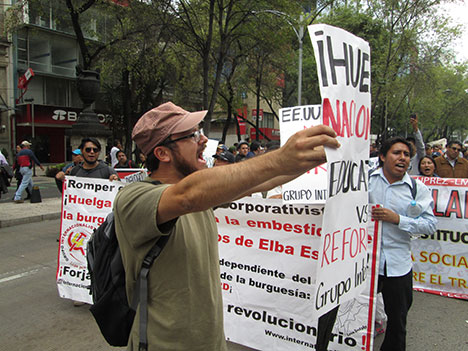 “For a National Strike
Against the Reforms” Contingent of the Grupo Internacionalista
in the CNTE “megamarcha,” September 3. (Photo: El Internacionalista)
“For a National Strike
Against the Reforms” Contingent of the Grupo Internacionalista
in the CNTE “megamarcha,” September 3. (Photo: El Internacionalista)In defending the CNTE against the charros of the corporatist SNTE, the GI has underscored the fundamental importance of the struggle for the independence of the unions from the capitalist state. You will never be able to defend the interests of teachers when the head of the organization is named by the country’s president, nor if the very existence of a union depends on the “toma de nota” (official recognition) of a Labor Secretary whose mission is to root out any trace of labor militancy. The way to break the shackles of corporatism, i.e., of state control of the teachers, is through a convulsive class struggle. The present moment is the best opportunity in decades to break free of the dead hand of the SNTE which has enchained teachers and been an obstacle to their struggle for decades.
For a long time, many CNTE activists as well as some groups on the left have called for the democratization of the SNTE. But this corporatist outfit can never be democratized without first breaking from state control. As shown by the imposition of Díaz de la Torre, like his predecessors Gordillo and Jonguitud, the SNTE is not based on the workers but on the capitalist state apparatus, of which it is a part. In the face of the onslaught by all the capitalist parties against the CNTE, spearheaded by the charros of the SNTE, simply in self-defense it is necessary to run out the entire bureaucracy, including the tens of thousands of comisionados (state-paid functionaries) who form the apparatus of the employer-government’s pseudo-union, and to occupy SNTE installations where possible, demonstrating in deeds that the CNTE is the real union.
Authentic communists reject all “evaluation” of teachers and students by authorities of the capitalist state who seek to destroy public education, break the unions and fire hundreds of thousands of teachers. A real evaluation, with scientific and pedagogical validity, which would serve to improve education rather than to penalize teachers, can only be carried out by the educators themselves, together with those who genuinely seek to enrich public education. This requires that schools be governed by councils of teachers, students, parents and workers.
In the Communist Manifesto (1848), Marx and Engels were among the first to call for “Free education for all children in public schools.” At the same time they called to “rescue education from the influence of the ruling class,” and in his “Critique of the Gotha Program” (1875), Marx added, that instead of appointing the state as educator of the people, “Government and church should rather be equally excluded from any influence on the school.”
A century ago, the capitalists accepted public education,
unwillingly, because of their need for a work force with basic
education. Today, the capitalists want to make use of the
education system to generate profits, to train a new
generation of wage slaves with skills and discipline without
the capacity of independent thought. In any just society, the
current school “reformers,” from the president of the republic
on down, would be severely punished for child abuse, among
their multiple crimes.
To arrive at such a society, working people must first rip power out of the hands of the exploiters and oppressors by means of a socialist revolution. For this, the first step is to form a revolutionary workers party based on the Trotskyist program of permanent revolution. This is the basic lesson to draw from the present teacher rebellion. ■
- 1. The PRI ruled Mexico for seven decades, from 1929 on, during much of that time as a one-party, corporatist state. After being defeated in the 2000 and 2006 elections, while still controlling many state governments, the PRI returned to the national presidency last year.
- 2. Even New York’s ex-mayor Giuliani (who was an advisor to Mexico City head of government Miguel Angel Mancera when the latter was Mexico City’s security secretary, i.e., head of the police, in the administration of Andrés Manuel López Obrador) got into the act, calling to jail the strikers.
- 3. In 1947, the PRI government took complete control of the until-then semi-corporatist unions, turning them into agencies of state control of labor by installing government-appointed union leaders. The first of these flunkeys was nicknamed El Charro for his fondness for dressing up in Mexican cowboy costume. See “SL on Corporatism in Mexico: Games Centrists Play,” The Internationalist, July 2013.
- 4. Campo Militar No. 1 was notorious as a torture center, where after the 2 October 1968 Tlatelolco Massacre, hundreds of students were held incommunicado in a “preventive jail,” many tortured and not a few “disappeared.”
- 5. The technocratic intellectual economic and political advisers of “modernizing autocrat” Porfirio Díaz (who ran Mexico almost uninterruptedly from 1876 to 1911) were known as “los científicos” (the scientists).
- 6. Secondary schools in impoverished rural areas with few teachers in which instruction is basically provided via television programs and videos.
No to the Energy “Reform,” Expropriate the Capitalists, Throw Out the Subcontractors!
Impose Workers
Control in Pemex and the
Federal Electricity Commission
A demonstration has been called for Saturday, August 31 in the Federal District and other states “in defense of the energy sector.” The basic document is a “Proclamation in Defense of the Nation” signed by unions such as the SME (electrical workers), the CNTE (teachers) and STUNAM (National University employees), as well as by prominent bourgeois politicians such as Cuauhtémoc Cárdenas and Mario Saucedo of the PRD, and intellectuals who have made a career out of tailing behind them. The document holds that “defense of the energy sector is the struggle for the nation,” and that “as Mexicans we are issuing a call for ¡ya basta! (enough!) to put an end to the looting of the profit from Petróleos Mexicanos and its prerogatives to explore, exploit, refine and distribute oil and gas products, which, among others such as mining and water resources, are the exclusive property of the nation according to constitutional definition” (La Jornada, 28 August).
This is a classic popular-front mobilization of class collaboration. By posing the opposition to the privatization measures in terms of defense of “national sovereignty,” Saturday’s mobilization, as well as dozens that have preceded it over the last decade and a half, is completely confined to the bourgeois terrain. Nationalist talk appealing to “true patriots” to fight against the “traitors to the fatherland” is intended to erase any class line. However, the interests of Mexican workers are essentially counterposed to those of the national exploiters. Therefore, for revolutionary Marxists it is fundamental to pose the battle against privatization of the energy sector in terms of class struggle.
Peña Nieto’s reform which, like those undertaken by Zedillo (PRI), Fox (PAN) and Calderón (PAN), would open up Pemex and the Federal Electricity Commission (CFE) to ever greater participation by private capital, is an attack on working people, not against the bourgeois “fatherland.” In self-defense, the Mexican proletariat must act with full class independence so that it can unleash its enormous social power. In seeking to head up the struggle against privatization, Cárdenas and López Obrador, along with the PRD and Morena, are simply trying to keep the mobilization under their control in order to prevent the anger of the working people from going beyond the framework of bourgeois pressure politics, mainly through parliament. In any case, none of them object to the participation of private capital in the energy sector, as long as it is “national” capital.
There are groups on the left which pose “renationalization” of the energy sector as the goal of the struggle. However, the nationalization of a particular industrial sector in the hands of a bourgeois regime is a common tool of the weak bourgeoisies in countries of belated capitalist development to carry out industrialization through investments that exceed the capacity of individual capitalists. Nevertheless, Trotskyists defend making the energy industry state property as a measure against the imperialists, who are eager to recover what they lost with the nationalization of oil by President Lázaro Cárdenas in 1938. Its privatization today would lead to a brutal attack on the workers.
To stop the bourgeois onslaught in its tracks, it is necessary that the workers occupy the plants, throwing out the administrators of the capitalist state and imposing workers control, both in Pemex and the CFE. This requires the formation of worker committees which fight against the corporatist “labor” gunmen of the STPRM (oil) and the SUTERM (electricity), as well as against the siren song of the bourgeois popular front around Cárdenas and López Obrador.
Such worker committees would open the financial books to demonstrate the falsity of the supposed “bankruptcy” of Pemex and the CFE, as well to confirm the depth of the “participation” of private capitalists in the sector. At the same time, they would expel all the private subcontractors (including those owned by the satraps of the corporatist pseudo-unions) and expropriate them without compensation in the framework of a struggle for a workers and peasants government that extends socialist revolution internationally.
The key to carrying out this perspective, which alone is capable of defeating Peña Nieto’s attack, is a revolutionary leadership, a communist vanguard armed with the Trotskyist program of permanent revolution. ■
